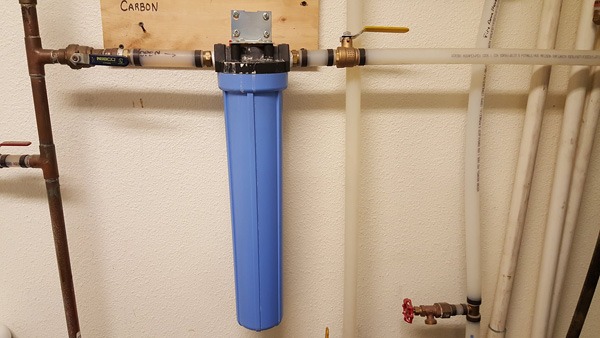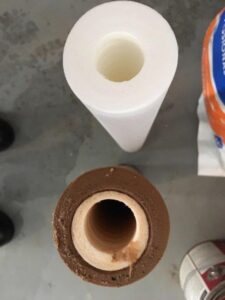You walk into a house – maybe you’re living in it, maybe you’re thinking about living in it – and you stop by one of the bathrooms. You notice something in the bottom of the toilet and at first, you’re completely grossed out, ready to run… then you realize that it is actually sand or silt at the bottom. You’re less grossed out, but still concerned – which led you to search online for a solution. Your search led you to us and we’d like to help.
Step 1: If there is a filter housing between the water source and the house, change the filter inside. It should look something like this:
Sometimes the housings are smaller, sometimes bigger… If you’re not sure what filter you need, get in touch with us and we will help you out.
Step 2: If there is not a filter housing between the water source and the house, we can help you by answering the following questions:
- What type of sediment is in the water?
- What size micron filter will catch the sediment?
- Are you sure a sediment filter will solve the problem?
The type of sediment will determine the filter you need and how often you might have to change it. For sandy sediment in which you can see individual particles, a larger micron filter will usually work. However, if the sediment is extremely fine or slimy, you need one with a much smaller micron rating.
Choosing the wrong size micron filter can lead to a couple of issues. First, if you choose a filter that is too large, sediment will still get through and can continue to damage your pipes, appliances, and if you already have a water softener or reverse osmosis system, it will foul those too (and raise the cost of repair). Second, if you choose a filter that is too small, it will plug quickly and cause water pressure loss and again, affect the function of appliances and water treatment equipment.
**Important note: sediment filters work best when changed regularly. If just starting out, check the filter weekly to see how long it will last. Once you get an idea of your change interval, make a calendar for reminder. Some water sources require more frequent changes. The frequency is ultimately a function of the water quality and the water usage. We have a few customers whose water source has high sediment loading and have to change their filters every 10-14 days. Others can get buy after a couple of months. In most cases, we recommend changing the sediment filter monthly. Below are two filters – one brand new, and one only a month old. When this filter was changed, the customer had almost no water pressure in the house. We changed the filter and the water started flowing.
Finally, are you sure that a sediment filter will solve your problem? We highly recommend installing a sediment filter on any water coming from a ground source and before any water treatment equipment. When we install a water softener, we always include a sediment filter housing to protect and prolong the life of the equipment and your other water using appliances (hot water heater, dishwasher, washing machine).
With that said, sometimes what you are seeing in toilets or sinks is actually minerals that were dissolved in the water, but precipitated out through water usage. Most commonly, these would be hardness minerals – calcium and magnesium that scale and crust on faucets. Another would be iron – at certain levels, iron will stain sinks, toilets and showers and cause problems in washing machines and other appliances. Instead of – or in addition to – a sediment filter, you may really be in need of other equipment to address the issue.
If you don’t already have the answers to the three questions above, give us a call at 307-672-7606 or bring a water sample and we’ll help you get the right answer. There are many water treatment options out there, we’d like you to have one that is customized to your specific needs.






